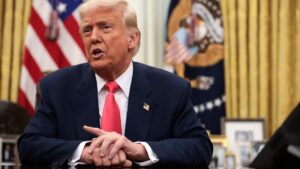The Truth About Tariffs: What You Need to Know
As discussions about tariffs and trade policies escalate in Washington, it’s essential to cut through the noise and understand the implications for the U.S. economy. Recently, President Donald Trump asserted that tariffs would make America "rich." However, experts caution that the expected revenue from these tariffs may fall considerably short of these optimistic projections. At Extreme Investor Network, we aim to illuminate the complexity of these economic transactions and their ramifications for all investors, businesses, and consumers.
The Revenue Illusion
White House trade adviser Peter Navarro has suggested that tariffs could generate approximately $600 billion annually—amounting to a staggering $6 trillion over ten years. In addition, he proposed that auto tariffs could inject another $100 billion annually into federal coffers. However, economists are skeptical, warning that such forecasts might be inflated. According to Mark Zandi, chief economist at Moody’s, the realistic revenue could be in the range of $100 billion to $200 billion per year—a far cry from the Trump administration’s lofty ambitions.
Understanding the Mental Math
When we hear figures thrown around, it’s crucial to assess the underlying calculations. A proposed 20% tariff on all U.S. imports, which totaled around $3.3 trillion in 2024, could theoretically yield about $660 billion. Yet, as Ernie Tedeschi, director of the Yale Budget Lab, points out, this simplistic math neglects vital considerations. Real-world economic reactions—such as higher consumer prices, reduced consumption, and retaliatory tariffs from other nations—would severely diminish potential revenue.
If we account for these factors, a 20% tariff might realistically generate closer to $250 billion annually. While higher tariff rates—such as a 50% tax—could provide more revenue (estimations suggest up to $780 billion), such scenarios assume no adverse effects on economic growth. The reality is more complex, often leading to reduced overall economic activity and, consequently, lower revenues.
The Ripple Effects of Tariffs
Consumers are the first casualties in the tariff equation. A broad 20% import tariff could add between $3,400 and $4,200 to annual costs for the average U.S. household, according to the Yale Budget Lab. This uptick in expenses would likely lead to decreased demand for imported goods, ultimately hurting tariff revenue. Moreover, as U.S. companies grapple with rising costs, many may opt not to pass these expenses onto consumers, which could squeeze profit margins and lead to layoffs—further constraining tax revenues owed to the government.
Global trade partners are also poised to retaliate, enacting tariffs on U.S. goods, which can diminish the profitability of American exports. In essence, tariffs could trigger a cyclical downturn that undermines the very revenue they were meant to generate.
Political and Economic Ramifications
Understanding tariff policy is crucial for stakeholders at every level, particularly for investors. The Trump administration’s efforts to leverage tariffs as funding for tax cuts—estimated at a cost of around $4.5 trillion over a decade—could trigger a cascade of cuts elsewhere or lead to an increase in national debt should tariff collections fall short.
Moreover, the transient nature of these tariffs poses additional risk. They are implemented through executive orders and can be reversed by future administrations, leaving little assurance in long-term plans for revenue generation.
Why This Matters
At Extreme Investor Network, we recognize that the impacts of tariffs extend far beyond trade policy; they shape the financial landscape for consumers, businesses, and investors alike. It’s imperative to scrutinize the governmental revenue models and be prepared for possible shortfalls that could lead to broader economic challenges.
As these discussions unfold, staying informed and aware of the potential financial implications will empower investors and consumers to make educated decisions in an ever-changing economic environment.
In summary, while tariffs may be framed as a path to economic enrichment, the reality is far more nuanced and requires careful consideration. Don’t let misinformation sway your investment strategies—stay connected with the insights and analyses found at Extreme Investor Network for a clearer understanding of the financial world.

